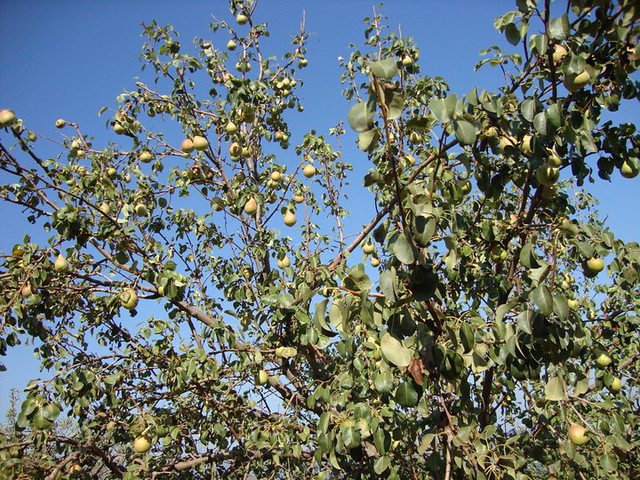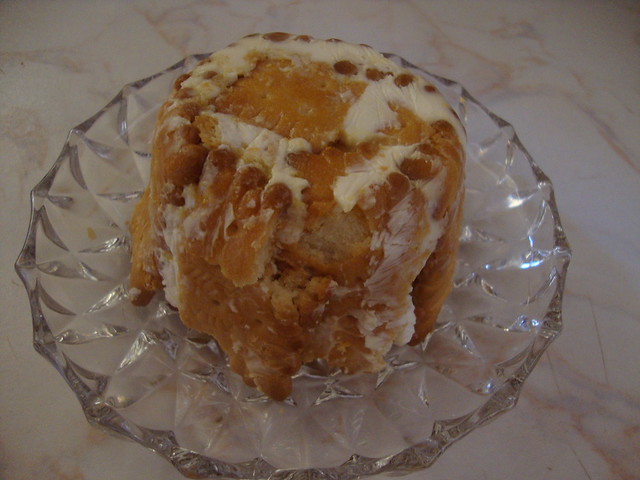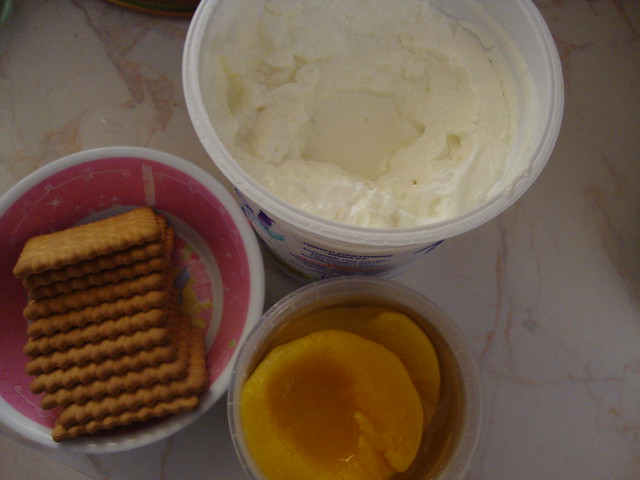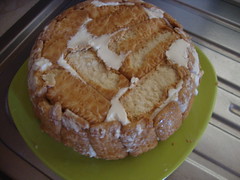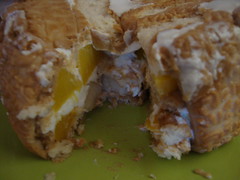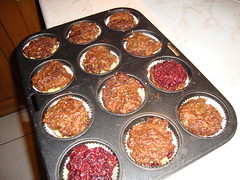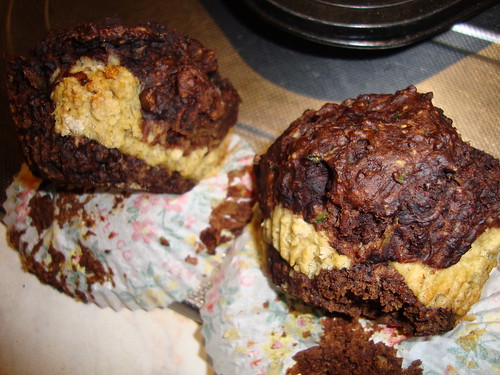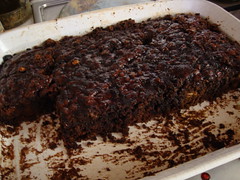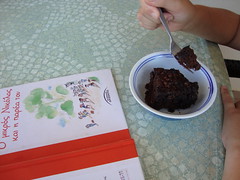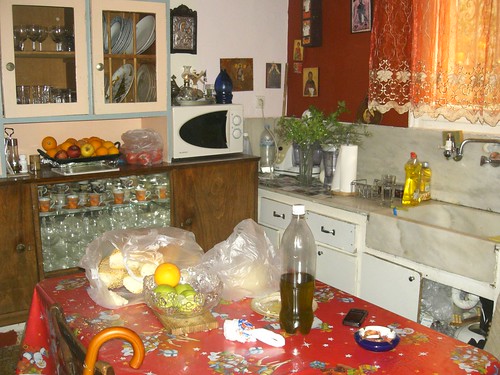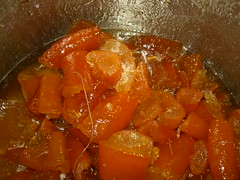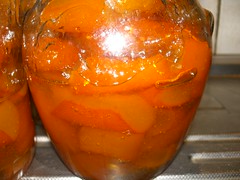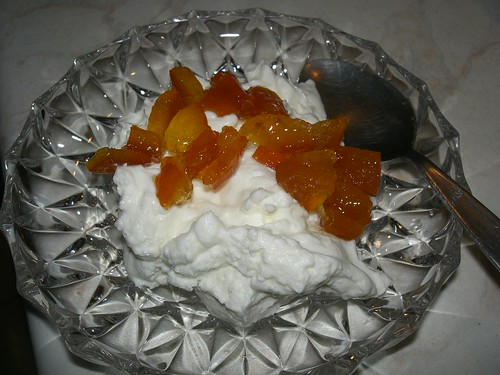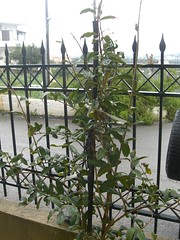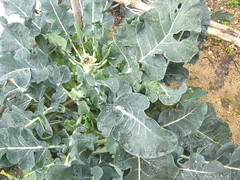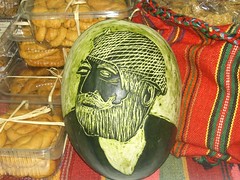After the children had left for school, after she had finished her coffee, and after she had had the first cigarette of the day, Varvara took off her nightdress and put on her garden trousers and shirt, which she washed every two weeks - when she couldn't stand the smell any more - and her gumboots, and the heavy jacket to keep the cold off her back. Despite the sunny weather, the village was freezing at that time of the morning. She did these things in routine fashion, like she did every morning when she went to the chicken coop, to drop off some feed, pour some fresh water into the pans and see if there were any eggs to be picked, because these days the hens were not laying, due to the cooler weather.
Her first thoughts of the day were always with the weather in mind. The deceptive sun, coming out full blast in the early hours of the morning, despite the foggy frost that hung low in the valley between the mountains where the village was located, had fooled her last winter, which ended up for her in a stay in hospital with suspected pneumonia. When she pleaded with the doctor to allow her to let her have her treatment at home so that she could at least be near her family, the doctor refused. (Unbeknownst to Varvara, her husband had explained to the doctor that they had no heating, so it would be best - and would work out more cheaply - if Varvara stayed at the hospital rather than risk exacerbating what was already a critical condition.) He reprimanded her for smoking which he said was the main cause of the advanced stage of her illness, even though Varvara could see where he kept his own cigarettes (in his shirt pocket under his doctor's jacket). She couldn't stand the thought of leaving the family in this way again, so she snuggled up in one of her husband's heavy jackets as she made the ten-minute walk to the chicken coop there and back.
Her second thought that day was that she wished she had feathers. Before she approached the coop, she could see the chickens snuggled together, and she felt the warmth they shared with each other. Their tiny heads were cocooned into their necks, which extended when they realised it was their carer who was approaching. They slowly made their way towards her as she unlocked the gate. She kicked her legs in the air, dancing like Zorba, like she did every morning (and afternoon) when she moved among them and they got too close to her legs, not out of fear of being pecked, but because she was worried she might step on them, clumsy things. This time, she stopped to stare at them a little longer, wondering which one she would slaughter at the end of the week for the party on the occasion of her son's nameday. None seemed to stand out. She checked the coop for eggs, but there weren't any. The hopeful bowl she was carrying would be going back home empty.
On the way back to the house, Varvara stopped to talk to the neighbours, like she did on most sunny mornings, most of whom were awake by now, and airing their houses. For some reason, even if she were five minutes out of her daily routine, Fofi was always just opening the shutters when she was returning home in the morning. "Hey Varvara, no eggs today, huh? Mine aren't laying, either." Misery needs company, she thought. Fofi made a little bit of pocket money here and there with sewing repairs which she did in her home. Fofi and Varvar often spent time in each other's house in the evening, coffee and a chat, when Fofi couldn't work due to the lack of natural light. Although she had little in common with Varvara, the two women shared the camaraderie of mothers and wives; such routines rarely changed no matter what teh circumstances a woman lived in.
Then Io shouted out her customary "Kalimera" and not much else, as Io was not much of a conversationalist. Io was up early today, Varvara noted; she normally didn't catch sight of Io in the mornings, only on the afternoon chicken run. Io had finished working as a hotel chamber maid last week, with the end of the tourist season - she was one of the lucky ones who had had some work during the summer. This morning, Varvara found her dressed up, which meant she was probably going to catch the bus and go into town.
Finally, she came across Bia who was sweeping her yard of the falling leaves of the grapevine which had now turned autumnal. Brown leaves were crumbled all over it; last night's wind had swept them up into the pomegranate tree that stood in one corner of the yard, full of fruit that was rarely picked on time before it fell - splat! - onto the ground, each piece of fruit spilling out its contents over the cement. On seeing this very often in the last month, Varvara had asked Bia to give her some of the fruit - she wouldn't have cared if it were picked up from the ground - but Bia told her that it was her daughter's favorite fruit, and there wouldn't be enough of it to send her up north where she was studying if she gave it away. Varvara was taken aback by this as she could clearly see pomegranate seeds - and grapes - squashed on the ground, but she let it pass. It was none of her business what Bia did with her possessions. She continued to smile and greet Bia every morning, and she still gave Bia an egg or two when she asked for it occasionally, to add to a cake or whatever she was making, which was probably going to be sent up north to that daughter of hers.
They chatted about nothing in particular, like they did most mornings: what they were planning to cook (Varvara had some green beans in the freezer that she intended to use up), how the kids were doing at school (only Varvara's - Bia's daughter was not under surveillance any longer, and at any rate, she had done what was expected of her, which was to finish school and get into university), how work was going (their husbands' jobs, as they were both unemployed), and how chilly it was in the mornings these days. By this time, the heavy coat was making Barbara sweat, but she dared not take it off, because her house was located at the end of the road in a dark no-exit lane, which did not often get much sunlight. She could not forget the trembling chills she felt when she initially fell ill.
 Neither was the episode with the pomegranates so easy to forget because the pomegranate tree reminded her of her parents' home, and her own village roots before she left as a bride. The yard was similar to Bia's, covered in a vineyard in the summer, with a pomegranate in one corner. In those days, she ate as many pomegranates as she could manage, and grapes for that matter. Her father would cover each grape cluster with plastic bags to protect it against the autumn weather, and they would cut off bunches to eat as needed. There was also a walnut tree in the field across from the house where the family kept sheep, sandwiched between a fig tree and a prickly pear plant. There was never any shortage of fruit in her family home. In fact, there was so much fruit that their neighbours would come and pick their fair share of it too. It had been a long time since she had last visited her parents when the pomegranates were ripe; this summer, they hardly had enough money to cover the petrol costs to go to the beach, let alone visit her parents two hours away. And of course, pomegranates don't come in the community grocery's monthly handouts, only dry staples.
Neither was the episode with the pomegranates so easy to forget because the pomegranate tree reminded her of her parents' home, and her own village roots before she left as a bride. The yard was similar to Bia's, covered in a vineyard in the summer, with a pomegranate in one corner. In those days, she ate as many pomegranates as she could manage, and grapes for that matter. Her father would cover each grape cluster with plastic bags to protect it against the autumn weather, and they would cut off bunches to eat as needed. There was also a walnut tree in the field across from the house where the family kept sheep, sandwiched between a fig tree and a prickly pear plant. There was never any shortage of fruit in her family home. In fact, there was so much fruit that their neighbours would come and pick their fair share of it too. It had been a long time since she had last visited her parents when the pomegranates were ripe; this summer, they hardly had enough money to cover the petrol costs to go to the beach, let alone visit her parents two hours away. And of course, pomegranates don't come in the community grocery's monthly handouts, only dry staples.
She opened the door to her house, which she never locked when she left it, because there was nothing to steal in it, and the dogs in the neighbourhood - including Giselle, her own little cocker spaniel - would bark so loudly that everyone would run out to see what was going on if ever anyone approached their rented home. They had recently moved to it, after they decided to move out of the previous home they rented in the same village, because they could not afford the heating costs in the winter. The landlord refused to allow them to install a wood fire because it would mean cutting holes into the wall. So they felt lucky to find the house they were now living in, since it came with the wood fire heater, and they didn't need to buy one.
But they didn't count on the tactics of the new landlord - a banker who lived in the town; he inherited the house from his late mother, who lived in it till he moved her out to live with him, so he could rent it. If a day went past and the rent was due and not deposited into his bank account, he'd call them up. And if another day passed, he'd call them up again and remind them that there are other people out there who want to rent the house and can afford to pay him. They lived under these threats throughout the summer when Varvara's husband was out of work off and on, being called to work one day in the aluminum factory in a week, and then no days the nest week, and then two or three days the week after that, whatever the boss said, whenever there was work. They had survived on the honey sales, her husband's sideline, which brought in whatever little money it could, to tide them through the summer, until the winter brought forth more work at the factory. She had sent the children to her parents then, so they could take them to the beach close to her seaside village. She had spent most of the summer in the house, looking longingly at the wood fire heater, which would once again start working in the colder months, cooking all her meals, so she could save on electricity and gas.
As she entered the house, she found Raki, the tiny black labrador her husband had recently adopted (he had lost his hunting dog and needed a replacement), hanging around by the door. This was unusual, as Raki knew her and never bothered to approach her when she entered, to sniff her out in case she were a stranger. Anxiety overcame her - had someone else entered the house? The door was closed, but it had been left unlocked...

And then she caught sight of the pomegranates in the plastic bag. They were huge, much bigger than any she'd seen on Bia's tree. The burglar must have left them behind by accident. Who on earth could have left them? She picked up the bag to take one out - it was bigger than her hand. And then, she saw the plastic bag full of empty honey jars, and felt relieved. She must have just missed Maria. She would recognise the jars anywhere - Varvara had been filling them herself for the last decade. Maria must have dropped the children off at school and Varvara had just missed her. She wished that she had come back earlier and not bothered today with Bia's selfish world. The pomegranates had made her day though. It would be easier to get through the day with them for company.
©All Rights Reserved/Organically cooked. No part of this blog may be reproduced and/or copied by any means without prior consent from Maria Verivaki.
Her first thoughts of the day were always with the weather in mind. The deceptive sun, coming out full blast in the early hours of the morning, despite the foggy frost that hung low in the valley between the mountains where the village was located, had fooled her last winter, which ended up for her in a stay in hospital with suspected pneumonia. When she pleaded with the doctor to allow her to let her have her treatment at home so that she could at least be near her family, the doctor refused. (Unbeknownst to Varvara, her husband had explained to the doctor that they had no heating, so it would be best - and would work out more cheaply - if Varvara stayed at the hospital rather than risk exacerbating what was already a critical condition.) He reprimanded her for smoking which he said was the main cause of the advanced stage of her illness, even though Varvara could see where he kept his own cigarettes (in his shirt pocket under his doctor's jacket). She couldn't stand the thought of leaving the family in this way again, so she snuggled up in one of her husband's heavy jackets as she made the ten-minute walk to the chicken coop there and back.
Her second thought that day was that she wished she had feathers. Before she approached the coop, she could see the chickens snuggled together, and she felt the warmth they shared with each other. Their tiny heads were cocooned into their necks, which extended when they realised it was their carer who was approaching. They slowly made their way towards her as she unlocked the gate. She kicked her legs in the air, dancing like Zorba, like she did every morning (and afternoon) when she moved among them and they got too close to her legs, not out of fear of being pecked, but because she was worried she might step on them, clumsy things. This time, she stopped to stare at them a little longer, wondering which one she would slaughter at the end of the week for the party on the occasion of her son's nameday. None seemed to stand out. She checked the coop for eggs, but there weren't any. The hopeful bowl she was carrying would be going back home empty.
On the way back to the house, Varvara stopped to talk to the neighbours, like she did on most sunny mornings, most of whom were awake by now, and airing their houses. For some reason, even if she were five minutes out of her daily routine, Fofi was always just opening the shutters when she was returning home in the morning. "Hey Varvara, no eggs today, huh? Mine aren't laying, either." Misery needs company, she thought. Fofi made a little bit of pocket money here and there with sewing repairs which she did in her home. Fofi and Varvar often spent time in each other's house in the evening, coffee and a chat, when Fofi couldn't work due to the lack of natural light. Although she had little in common with Varvara, the two women shared the camaraderie of mothers and wives; such routines rarely changed no matter what teh circumstances a woman lived in.
Then Io shouted out her customary "Kalimera" and not much else, as Io was not much of a conversationalist. Io was up early today, Varvara noted; she normally didn't catch sight of Io in the mornings, only on the afternoon chicken run. Io had finished working as a hotel chamber maid last week, with the end of the tourist season - she was one of the lucky ones who had had some work during the summer. This morning, Varvara found her dressed up, which meant she was probably going to catch the bus and go into town.
Finally, she came across Bia who was sweeping her yard of the falling leaves of the grapevine which had now turned autumnal. Brown leaves were crumbled all over it; last night's wind had swept them up into the pomegranate tree that stood in one corner of the yard, full of fruit that was rarely picked on time before it fell - splat! - onto the ground, each piece of fruit spilling out its contents over the cement. On seeing this very often in the last month, Varvara had asked Bia to give her some of the fruit - she wouldn't have cared if it were picked up from the ground - but Bia told her that it was her daughter's favorite fruit, and there wouldn't be enough of it to send her up north where she was studying if she gave it away. Varvara was taken aback by this as she could clearly see pomegranate seeds - and grapes - squashed on the ground, but she let it pass. It was none of her business what Bia did with her possessions. She continued to smile and greet Bia every morning, and she still gave Bia an egg or two when she asked for it occasionally, to add to a cake or whatever she was making, which was probably going to be sent up north to that daughter of hers.
They chatted about nothing in particular, like they did most mornings: what they were planning to cook (Varvara had some green beans in the freezer that she intended to use up), how the kids were doing at school (only Varvara's - Bia's daughter was not under surveillance any longer, and at any rate, she had done what was expected of her, which was to finish school and get into university), how work was going (their husbands' jobs, as they were both unemployed), and how chilly it was in the mornings these days. By this time, the heavy coat was making Barbara sweat, but she dared not take it off, because her house was located at the end of the road in a dark no-exit lane, which did not often get much sunlight. She could not forget the trembling chills she felt when she initially fell ill.

She opened the door to her house, which she never locked when she left it, because there was nothing to steal in it, and the dogs in the neighbourhood - including Giselle, her own little cocker spaniel - would bark so loudly that everyone would run out to see what was going on if ever anyone approached their rented home. They had recently moved to it, after they decided to move out of the previous home they rented in the same village, because they could not afford the heating costs in the winter. The landlord refused to allow them to install a wood fire because it would mean cutting holes into the wall. So they felt lucky to find the house they were now living in, since it came with the wood fire heater, and they didn't need to buy one.
But they didn't count on the tactics of the new landlord - a banker who lived in the town; he inherited the house from his late mother, who lived in it till he moved her out to live with him, so he could rent it. If a day went past and the rent was due and not deposited into his bank account, he'd call them up. And if another day passed, he'd call them up again and remind them that there are other people out there who want to rent the house and can afford to pay him. They lived under these threats throughout the summer when Varvara's husband was out of work off and on, being called to work one day in the aluminum factory in a week, and then no days the nest week, and then two or three days the week after that, whatever the boss said, whenever there was work. They had survived on the honey sales, her husband's sideline, which brought in whatever little money it could, to tide them through the summer, until the winter brought forth more work at the factory. She had sent the children to her parents then, so they could take them to the beach close to her seaside village. She had spent most of the summer in the house, looking longingly at the wood fire heater, which would once again start working in the colder months, cooking all her meals, so she could save on electricity and gas.
As she entered the house, she found Raki, the tiny black labrador her husband had recently adopted (he had lost his hunting dog and needed a replacement), hanging around by the door. This was unusual, as Raki knew her and never bothered to approach her when she entered, to sniff her out in case she were a stranger. Anxiety overcame her - had someone else entered the house? The door was closed, but it had been left unlocked...

And then she caught sight of the pomegranates in the plastic bag. They were huge, much bigger than any she'd seen on Bia's tree. The burglar must have left them behind by accident. Who on earth could have left them? She picked up the bag to take one out - it was bigger than her hand. And then, she saw the plastic bag full of empty honey jars, and felt relieved. She must have just missed Maria. She would recognise the jars anywhere - Varvara had been filling them herself for the last decade. Maria must have dropped the children off at school and Varvara had just missed her. She wished that she had come back earlier and not bothered today with Bia's selfish world. The pomegranates had made her day though. It would be easier to get through the day with them for company.
©All Rights Reserved/Organically cooked. No part of this blog may be reproduced and/or copied by any means without prior consent from Maria Verivaki.











 More preserved fruits - sour cherries, kumquat, biterr orange and unripe figs.
More preserved fruits - sour cherries, kumquat, biterr orange and unripe figs.




